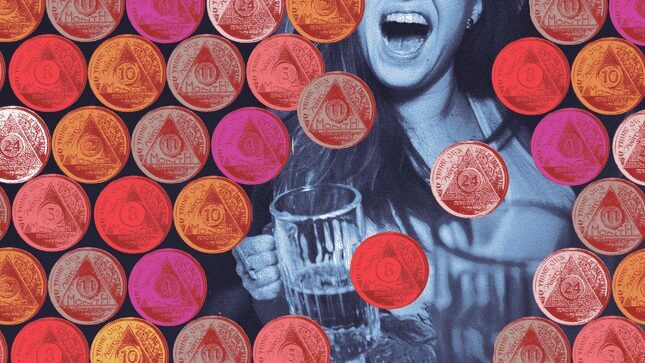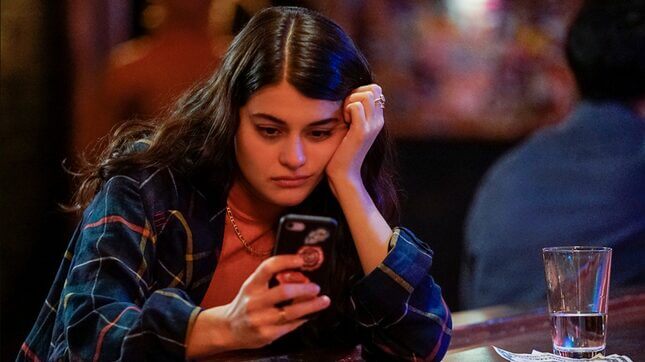Sober Women and the Fear of Becoming Boring
Recent pop culture—like Single Drunk Female and the courageous revelations by Cara Delevingne—is inspiring women to examine their hangups around sobriety.
In Depth
Graphic: Vicky Leta; Images: Shutterstock
Fifteen years ago, I lived in a German village with a population of 659, including one town drunk. Herman wore a Tyrolean hat every day despite the fact that we were nowhere near the Alps. He was always smiling, drawing attention to his permanently pink nose and blushed cheeks, like a Hummel figurine. One day, Herman wasn’t around anymore. My family was saddened by it, but that was that. He was “Herman the town drunk,” until he wasn’t anything at all.
In many ways, a combination of ignorance, cruelty, and pop culture led me to see Herman as the true image of the alcoholic, and certainly by extension, the addict: a caricature and a man. It’s something Single Drunk Female creator Simone Finch calls “the stereotype of the white, older male addict, done over and over and over again.” (A woman drinking heavily, alone at the end of a hectic day? That’s just unwinding.) Reality is more complicated: Men are more likely than women to use, but women are just as likely as men to develop substance use disorder. In the last decade, much has been made about women “closing the gender gap” in terms of alcohol use disorder. One study found women with young children increased their drinking by more than 300% during the pandemic.
At the same time, women have become a central focus of cultural conversations surrounding sobriety. Following the 2015 release of Sarah Hepola’s Blackout: Remembering the Things I Drank to Forget, many of the popular memoirs on the topic have been written by women: Sarah Levy’s Drinking Games: A Memoir, Erica C. Barnett’s Quitter: A Memoir of Drinking, Relapse, and Recovery, and Clare Pooley’s The Sober Diaries. “More often, young women were going into rehab. Women are drinking more than they ever had in recorded history,” Hepola tells me. “It’s no coincidence that there are a rash of books about drinking too much and sleeping with the wrong men.”

Similarly, the aforementioned Freeform series Single Drunk Female may very well be the first major U.S. TV show to portray sobriety in this particular way for women—a foil to Rue Bennett’s battle with addiction on the dark, druggy high school drama Euphoria, where characters weave in and out of inebriation. Supermodel/actor/forever cool girl Cara Delevingne recently announced she was four months sober after unsettlingly disheveled photos of her at an airport surfaced. On her daytime talk show, Drew Barrymore unabashedly talks about sobriety with guests.
Women are no longer hiding their drinking (pre-Prohibition), no longer drinking simply to mirror men’s power (the Mad Men era), or drinking as a form of feminism (in the ‘70s, when bars permitted unescorted women to order, and in the 2010s, when “just stop drinking” was used as sexist advice to curb sexual assault). They’re accepting that drinking no longer needs to be central to all social activity (Sex and the City), nor is it the only way to articulate darkness and depth (Jessica Jones, any “badass babe” on TV clutching a whiskey glass, even Fleabag). They’re considering stopping altogether. Or, at the very least, sobriety has entered the chat.
But when drinking and doing drugs has long been associated with intrigue, temperance must compete with generations of “cool.” Can it go the way of smoking cigarettes? Or does sobriety, to most people, just seem pretty fucking boring?
In the pilot episode of Single Drunk Female, protagonist Samantha Fink, expertly portrayed by Sofia Black-D’Elia, goes to work drunk. (It’s not BuzzFeed, but the website she writes for is called Bzzz, so you do the math. Journalism and alcohol have long been intertwined.) In one particularly pathetic moment, she struggles to get a phone away from her supervisor as he tries to call security on her and ends up striking him in the head. As a result, she loses her job, goes to rehab, participates in court-mandated community service, moves back home to her mother’s house, and tragically, relapses before getting clean. These wild stories of carousing are likely why, when the show debuted in January 2022, its first episode was the most-watched Freeform comedy series premiere on Hulu, with over 2.4 million viewers and a perfect 100% score on Rotten Tomatoes.
As the season progressed, those numbers dropped—just as Sam’s sobriety really kicked in. Compare that to, say, the first season of Euphoria, when Rue (played by Zendaya) mentions that after rehab, she has “no intention of staying clean,” and then spends the next two seasons proving it. The most popular episodes are typically the ones where she is suffering the most. There are endless factors that could account for the Single Drunk Female slump—not everyone watches a show all the way through, maybe some felt the quality waned (it didn’t)—but one takeaway is curiously dark: Viewers, sober or not, only like the electric drunk tales.
-

-

-

-

-

-

-

-

-

-

-

-

-

-

-

-

-

-

-

-

-

-

-

-

-

-

-

-

-

-

-

-

-

-

-

-

-

-

-

-








































